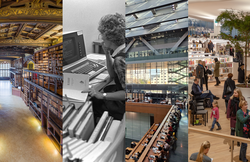
Back مكتبة عامة Arabic Javna biblioteka BS Biblioteca pública Catalan Folkebibliotek Danish Öffentliche Bibliothek German Δημόσια βιβλιοθήκη Greek Publika biblioteko Esperanto Biblioteca pública Spanish Rahvaraamatukogu Estonian Liburutegi publiko Basque
| Public library | |
|---|---|
Bibliothèque, Adrar, Algeria Public library, Maadi, Egypt Interior of the Central Library, Tampere, Finland Entrance of National Library, Tehran, Iran |
| Part of a series on |
| Library and information science |
|---|
 |
A public library is a library, most often a lending library, that is accessible by the general public and is usually funded from public sources, such as taxes. It is operated by librarians and library paraprofessionals, who are also civil servants.
There are five fundamental characteristics shared by public libraries: (1) they are generally supported by taxes (usually local, though any level of government can and may contribute); (2) they are governed by a board to serve the public interest; (3) they are open to all, and every community member can access the collection; (4) they are entirely voluntary, no one is ever forced to use the services provided; and (5) they provide library and information services without charge.[1]
Public libraries exist in many countries across the world and are often considered an essential part of having an educated and literate population. Public libraries are distinct from research libraries, school libraries, academic libraries in other states and other special libraries. Their mandate is to serve the general public's information needs rather than the needs of a particular school, institution, or research population. Public libraries also provide free services such as preschool story times to encourage early literacy among children. They also provide a quiet study and learning areas for students and professionals and foster the formation of book clubs to encourage the appreciation of literature by the young and adults. Public libraries typically allow users to borrow books and other materials outside the library premises temporarily, usually for a given period of time. They also have non-circulating reference collections and provide computer and Internet access to their patrons.
- ^ Rubin, Richard E. Foundations of Library and Information Science (3rd ed). 2010. Neal-Schuman Publishers: New York.






